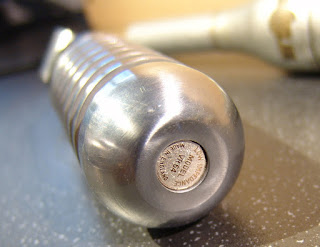 |
| Add caption |
I always thought that Lustraphone had one of the coolest logos, a bit reminiscent of The Man From UNCLE TV series. Different models have different styles of badges, either applied as a decal or a sticker.
The output transformers have a slight quirkiness, in that the bobbin is pushed halfway through the frame of the mic before the laminations are added, which neatly solves the problem of mounting the tranny.
 |
| Lustraphone VR64 inside |
| Lustraphone VR64 motor - rear view showing magnets |
I'm not sure if having a layer of insulator between the laminations has any sonic effect, beyond the fact that the transformer has one fewer layer of laminations in the stack, and so a lower inductance and higher cutoff frequency. Probably little or none.
The 15 ohm transformer is made up from 15 turns of 0.85 mm wire for the primary, and about 145 turns of 0.3 mm for the secondary, giving a ratio just under 1:10. This one was re-wound for 300 ohms using the original lams, which gives a better output level into a modern preamp, whilst retaining the vintage character.
 |
| Lustraphone transformer autopsy |
This example had a quick release mounting system. A bullet shaped part screws onto the mic stand, and then the mic is pushed onto it. Very cunning!
 |
| Lustraphone quick release mic mount |
There was also a stereo model, the VR65, which was basically two mics stacked one on top of the other, with the upper mic rotated by 90 degrees for Blumlein pair recording. There are some sound clips on this thread over at Gearslutz.
 |
| Lustraphone VR65 stereo ribbon mic |
 |
| Lustraphone VR65 in action |
(Thanks to Santiago Ramos for permission to use the photos of his VR65)































